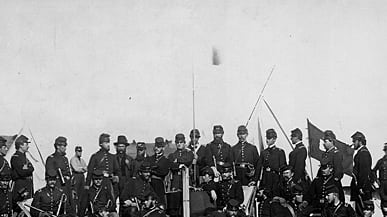The last time the United States observed a major anniversary of the Civil War, the centennial celebration in 1961–65, things quickly fell apart. When the Civil War Centennial Commission held a national convention in Charleston, S.C., where the war began with the firing on Fort Sumter in April 1861, it denied a black delegate admission to the convention’s segregated hotel. And in its official pronouncements and literature, the commission avoided any discussion of slavery, emancipation, or the participation of free African-Americans in the fighting. Such narrow-minded policies doomed the commission almost from the outset.
Gallery: Civil War Battlefields

As the 150th anniversary of the war’s beginning approaches, things look more promising. So far, the biggest fights have been about preserving land—keeping a Walmart out of the Wilderness battlefield and a casino away from Gettysburg. As for interpretation, the idea of promoting any particular agenda has given way to a preference for looking more closely at the testimony of people who lived through the conflict. In this regard, the sesquicentennial has already inspired one book that is simply indispensable—the Library of America’s The Civil War: The First Year Told by Those Who Lived It, one of four volumes planned.
ADVERTISEMENT
“It was strange to see that emblem of childhood, that token of a father’s love lying there amidst the dead and dying…”
Beginning in November 1860, with Abraham Lincoln’s election, the initial volume in this series re-creates—through diaries, speeches, letters, poems, and newspaper accounts—the thoughts and actions of star players and everyday citizens on both sides of the conflict. Some of this material, such as Lincoln’s First Inaugural Address or the diaries of George Templeton Strong and Mary Boykin Chesnut, is familiar. Much, however, is fresh, and all the entries become more striking by being placed in the context of time unfolding. Many would be striking no matter what the context.
Riding across the Bull Run battlefield in the wake of the fighting, Confederate soldier Charles Minor Blackford writes, “I noticed an old doll baby with only one leg lying by the side of a Federal soldier just as it dropped from his pocket when he fell writhing in the agony of death. It was obviously a memento of some little loved one at home which he had brought so far with him and had worn close to his heart on this day of danger and death. It was strange to see that emblem of childhood, that token of a father’s love lying there amidst the dead and dying … I dismounted, picked it up and stuffed it back into the poor fellow’s cold bosom that it might rest with him in the bloody grave which was to be forever unknown to those who loved and mourned him in his distant home.”

That, astonishingly, is a typical entry in this splendid literary tapestry. As the testimony accumulates, a profound portrait of a nation in crisis emerges, conjuring the epic quality of the conflict and its consequences as almost nothing before it. It is both mesmerizing and deeply troubling, and it will forever deepen the way you see this central chapter in our history. And while this is only the inaugural installment in the series, it does not seem the least bit rash to call this collage of testimony a masterpiece.
Malcolm Jones writes about books, music, and photography for The Daily Beast and Newsweek, where he has written about subjects ranging from A. Lincoln to R. Crumb. He is the author of a memoir, Little Boy Blues, and collaborated with the songwriter and composer Van Dyke Parks and the illustrator Barry Moser on Jump!, a retelling of Brer Rabbit stories.




